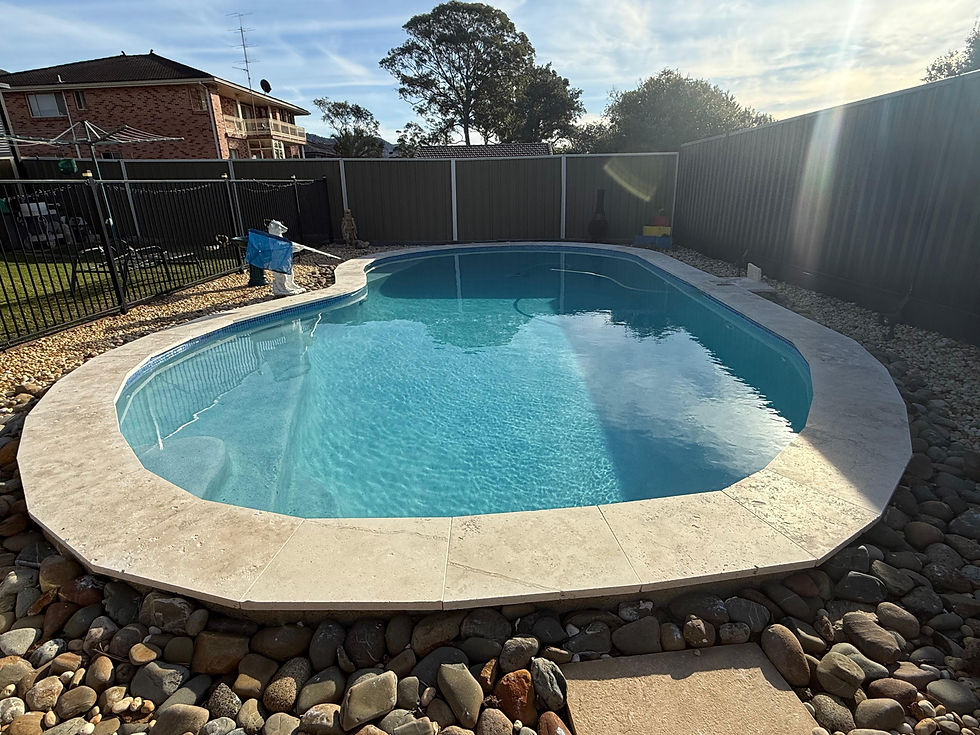Care Instructions for Your Glass Bead Pool
- SPLASH POOL & SPA
- Sep 23
- 3 min read
Updated: Sep 26

Congratulations on your newly resurfaced Glass Bead pool! To protect your investment and maintain your warranty, it’s essential to follow the correct start-up and care procedures. Please read the guidelines below carefully.
1. Filling Your Pool
Begin filling immediately after resurfacing is complete.
Do not stop or interrupt filling until the water reaches the middle of the skimmer box.
Once full, switch on your filtration system and engage the ‘backwash’ mode to wash and rinse the filter system.
Ensure the pump and filter are working correctly in line with the manufacturer’s instructions.
2. Initial Chemical Start-Up (Day 1)
Once the system has been checked and is running properly, add the following chemicals based on a 50,000-litre pool:
7 litres of liquid chlorine
1 litre of hydrochloric acid
2 kilograms of stabiliser
Run the pool filtration system continuously for the next 24 hours.
3. After 24 Hours (Day 2)
Add 2 kilograms of buffer.
Thoroughly brush the pool interior.
Wait 4–8 hours for sediment to settle, then vacuum the pool.
4. Ongoing First Week Care
Check and balance pool water chemistry using the following ranges:
pH: 7.2 – 7.6
Total Alkalinity: 80 – 120 mg/L
Calcium Hardness: 150 mg/L (first 12 months), then 100–250 mg/L thereafter
Chlorine: 1.5 – 3.0 ppm
Cyanuric Acid (Stabiliser): 2.5 – 4.0 ppm
Day 5: Brush and vacuum the pool interior again.
5. Saltwater Pools
If your pool is a saltwater system, wait 2 weeks before adding salt.
Always check the salt quantity recommended by your chlorinator manufacturer.
Never allow salt to sit on the pool surface — brush continuously until fully dissolved.
After 8 hours, switch on the salt chlorinator.
💧 Ongoing Water Care
Perform weekly water tests and adjust as required.
Carry out a comprehensive water test monthly and keep a record for warranty purposes.
Maintain a logbook of all chemical additions (date, product, dosage).
Regularly test and adjust:
pH
Chlorine
Total Alkalinity
Calcium Hardness
Cyanuric Acid
Metals
Acid Levels
Tip: Always collect water samples from about 45 cm (18 inches) below the surface, ideally near a return jet.
🧽 Maintenance Best Practices
Brush the pool surface twice weekly during the first 4 weeks, then weekly thereafter.
Clean the tiles and waterline regularly to prevent staining.
Run the filtration system daily (at least 8 hours).
Use a robotic or automatic cleaner if possible.
Keep water level above the skimmer at all times.
Avoid harsh acid washes or abrasive cleaning products.
Schedule professional servicing/inspection at least once a year.
🌟 Important Notes
Add chemicals gradually and pre-dilute where possible. Avoid sudden “shock” doses.
Do not leave the pool drained or partially drained for extended periods.
Follow these steps carefully — non-compliance may affect the longevity of your surface and void warranty coverage.
It’s vital for saltwater system swimming pools to use high-quality products that dissolve completely upon contact with water. If a product does not dissolve immediately, it’s important to use a pool brush or broom to distribute it, so that the undissolved material does not sit in one place on the pool surface. This helps to prevent stains or discolouration.
Using low-quality products, or failing to ensure proper dissolution, can lead to permanent stains on pool surfaces — damage that is usually not covered by warranty. Even products labelled for pool use can contain impurities or coarse particles that settle and react, especially if the salt used is of poor purity. In saltwater pools, metals or minerals introduced by impure salt can combine with chlorine or with pool surfaces to produce visible stains.
To avoid problems:
Always choose chemical and salt products specifically graded for pool / saltwater systems.
Pre-dissolve or distribute carefully, especially in areas where water circulation is weaker (steps, shallow ends).
Run circulation and filtration soon after adding chemicals to ensure even mixing.
Brush or sweep the pool surface if you notice undissolved product settling.
Maintain correct water chemistry (pH, chlorine levels, total alkalinity), which helps prevent discolouration and metal precipitation.
Dissolve first in a bucket if needed
Add slowly while pump/circulation is running
Brush / sweep undissolved granules
Test water after treatment
If you have any questions or need assistance with balancing your pool, please don’t hesitate to contact us. We’re here to support you and ensure your Glass Bead pool remains smooth, sparkling, and beautiful for many years to come.






Comments